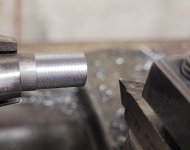Dobermann
Hot Rolled
- Joined
- Jan 2, 2014
- Location
- North Carolina
First a question: Are we looking at the result of hand-feeding the carriage or are we looking at the result of carriage feed by the lead screw? If not hand-fed, try that to see what you get.
Second, I have seen a pattern like that caused by a "buzzy" or electrically imbalanced single phase motor. The offending motor was not built in the USA if that's any hint as to its origin. We switched to a VFD driven 3-phase motor and the pattern went away. I'm not saying that's what's causing what you're seeing but it is possible.
Second, I have seen a pattern like that caused by a "buzzy" or electrically imbalanced single phase motor. The offending motor was not built in the USA if that's any hint as to its origin. We switched to a VFD driven 3-phase motor and the pattern went away. I'm not saying that's what's causing what you're seeing but it is possible.



